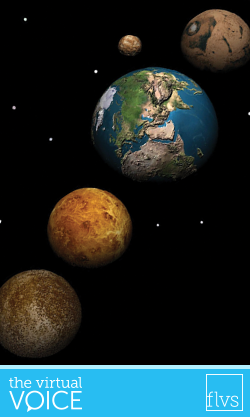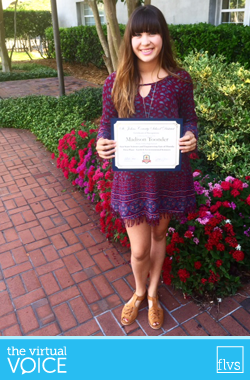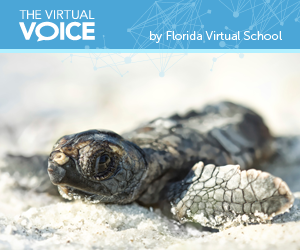Student Research
Aliens and Explosions
By Guest Blogger on March 30th, 2017
This post was written by FLVS student Sarah Weyand about her award-winning research in astrophysics.
 My science fair journey began about a year ago.
My science fair journey began about a year ago.
I was approached by a Harvard graduate who wanted to mentor a high school senior in an astrophysics and computer science research project.
I knew nothing about astronomy and I didn’t know a single programming language, but I love space and I plan to major in computer science in college. Naturally, I said yes. This project has taken me to the Science Talent Search, the Indian River Regional Science and Engineering Fair, and, now, the State Science Fair.
My project is titled Aliens and Explosions: How Supernovae Affect the Habitable Zones of Exoplanets.
The purpose of the project is to calculate the percentage of exoplanets, a planet that does not orbit our Sun, that would no longer be in the habitable zone of their host star due to a supernova, the explosive death of a massive star. Continue reading
Thankful for the Mountains We Climb
By Guest Blogger on November 22nd, 2016
 2016 is an incredible time to be a teacher.
2016 is an incredible time to be a teacher.
I am grateful for each and every day I get to work alongside the best of the best in education.
While expectations are high, standards seem impossible to meet, and the everyday trials and struggles we face seem endless, this time in our country and our world is truly an incredible time to be a teacher. We have so much more access to research about how and why we learn. We have clearer pictures of our brains and all they can accomplish.
We might be up against some very difficult mountains to climb, but the teachers that have gone before us have never been as well equipped as we are today.
As a teacher I’ve always been fascinated with the brain – how it operates so much more than just our physical bodies. Each and every day, new research is published confirming something I think teachers have always known. Continue reading
FLVS Student Pursues her Passion for Animals
By Guest Blogger on September 13th, 2016
This post was written by tenth grade high school student Madison Toonder. Read about Maddie’s oyster research in a previous blog post here.
 In October 2015, I was awarded a scholarship to attend any pre-collegiate program of my choice for winning second place in the nation in STEM mathematics at the Broadcom MASTERS national science fair competition in San Francisco, California.
In October 2015, I was awarded a scholarship to attend any pre-collegiate program of my choice for winning second place in the nation in STEM mathematics at the Broadcom MASTERS national science fair competition in San Francisco, California.
I chose the Cummings School of Veterinary Medicine at Tufts University’s two-week summer intensive in Massachusetts because it is directly related to my career path.
Tufts’ program is designed to give high school students insight into the rigors of veterinary school. During the program, we attended lectures, studied animal anatomy through fascinating dissections and hands-on palpitations, completed hospital rounds with fourth-year veterinary students, and explored the many different possible career paths within veterinary medicine. My daily agenda was varied and included activities such as learning proper techniques for handling animals, observing surgical procedures, and learning how to perform routine check-ups on a variety of different animals. One of my favorite activities was suturing bananas to practice proper technique. Continue reading
Student Researches Sunscreen’s Effects on Oysters
By Guest Blogger on October 28th, 2015
 Hi! I’m Madison, a student at FLVS.
Hi! I’m Madison, a student at FLVS.
While attending a Busch Gardens camp in the summer of 2014, I learned that the park utilizes oysters to naturally filter their lakes. I soon became fascinated with oysters, and after some research, I discovered oysters are dying globally due to pollution.
After this discovery, I formulated an experiment focusing on the effect of micronized chemical sunscreen (as used in spray sunscreen) and nanosized zinc oxide sunblock (as found in thicker, clear sunblock) on the ability of a bivalve mollusk (or oyster) to filter bay water. Continue reading
FLVS Student Studies Sea Turtle Hatchlings
By Guest Blogger on July 22nd, 2015

It’s 11:00 pm and the moon is shining brightly in the nighttime sky over the south Florida coastline.
A large sea turtle races against time as she climbs the beach’s slopes to find the perfect nesting site. After an hour, she finds it and begins to dig a deep nest and lay her eggs. In the end, only one sea turtle out of a thousand hatchlings will survive to adulthood.
Loggerhead sea turtles are an endangered species threatened by predators, pollution, poaching, and habitat degradation. Last year, I decided to look at sea turtle hatches because of their importance in the marine life cycle. A factor that negatively affects the sea turtle’s nesting habitat is beach erosion. Continue reading
